How to Maintain Pine Cabins Year-Round
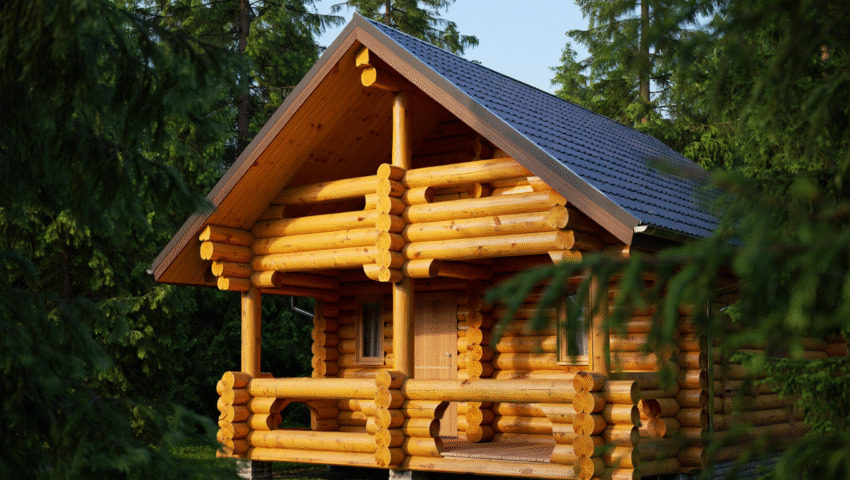
Owning a pine cabin offers a unique connection to nature. The warm, rustic appeal of wood creates a peaceful retreat. Yet, this natural beauty requires consistent attention. Proper pine cabin maintenance is the ongoing process of preserving the wood’s integrity and appearance. It involves cleaning, sealing, and inspecting the structure through every season. Without it, a dream cabin can face serious issues like rot, pests, and structural damage. Understanding the essentials of cleaning, pest control, sealing, and seasonal upkeep ensures the longevity of your investment. This guide provides a comprehensive approach to keeping your wooden haven in prime condition for years to come. To make this process easier, we’ve created a handy year-round checklist you can download at the end of this guide.
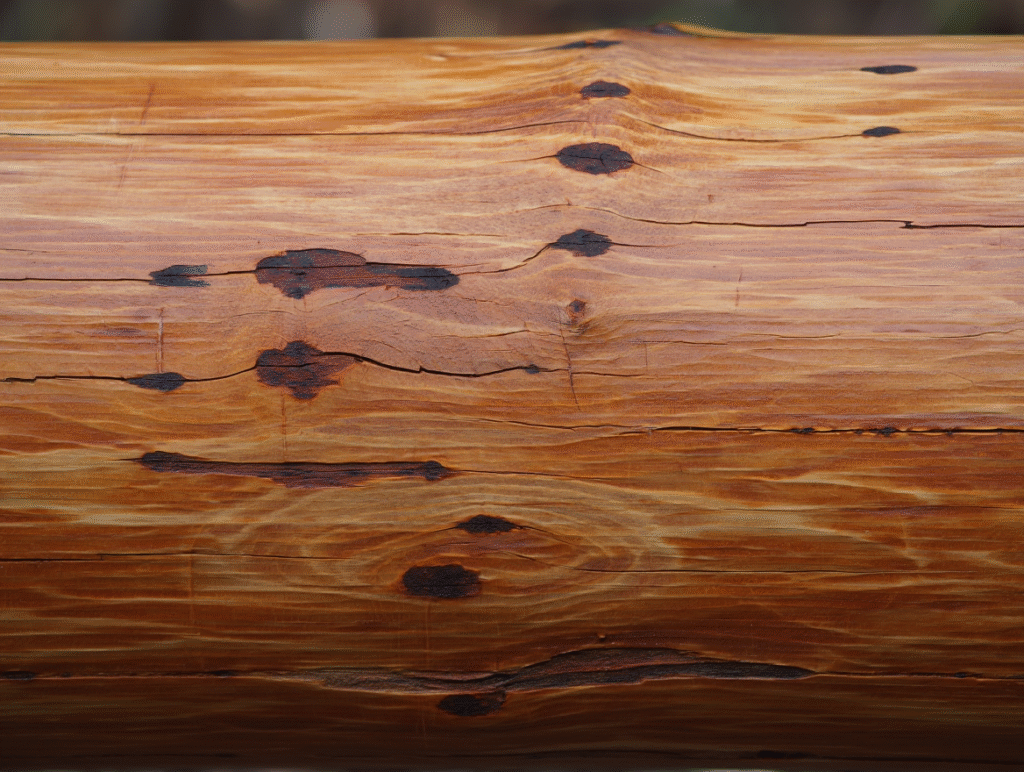
Why Pine Needs Regular Maintenance
Pine is a popular choice for log cabins, often selected over other wood types for its affordability and attractive grain. However, it is a softwood, making it more susceptible to environmental threats than hardwoods. Fungi, insects, and moisture can easily compromise unprotected pine. Consistent pine cabin maintenance protects the wood from these relentless elements. Neglecting this responsibility leads to costly repairs and diminished property value.
The Nature of Pine Wood
Pine logs contain natural resins and are less dense than other woods. This composition makes them vulnerable to moisture absorption. When water penetrates the logs, it creates a breeding ground for mold, mildew, and decay. Furthermore, insects like termites and carpenter bees find soft, damp wood an ideal place to nest. Regular cabin care directly addresses these inherent weaknesses. It creates a barrier that shields the wood from damage.
A study on wood preservation highlighted that untreated pine in humid climates can show significant decay within three to five years (Forest Products Laboratory, 2019, Madison, WI). This research underscores the necessity of a proactive approach. Understanding how to maintain pine wood involves more than just occasional cleaning; it requires a strategic, year-round plan. The effort invested in upkeep pays off by extending the life and beauty of your cabin. Proper pine log maintenance is not just a series of chores but a fundamental part of ownership.
Common Problems from Neglect
What happens when upkeep is ignored? The first sign is often discoloration. The wood may darken in patches due to mildew growth. Over time, the logs can feel soft or spongy to the touch, indicating rot. You might also notice small holes or sawdust piles, clear signs of an insect infestation. These issues are not just cosmetic. They can affect the structural stability of the entire cabin.
Neglecting seasonal cabin upkeep can lead to more severe problems. Water leaks from a poorly maintained roof can seep into the walls, causing widespread damage. Cracks in the foundation can widen, compromising the cabin’s entire structure. Eventually, these small, fixable issues can snowball into a major restoration project. Consistent attention prevents these problems from ever taking root, saving both money and stress. Good pine cabin maintenance is the best defense against long-term deterioration.
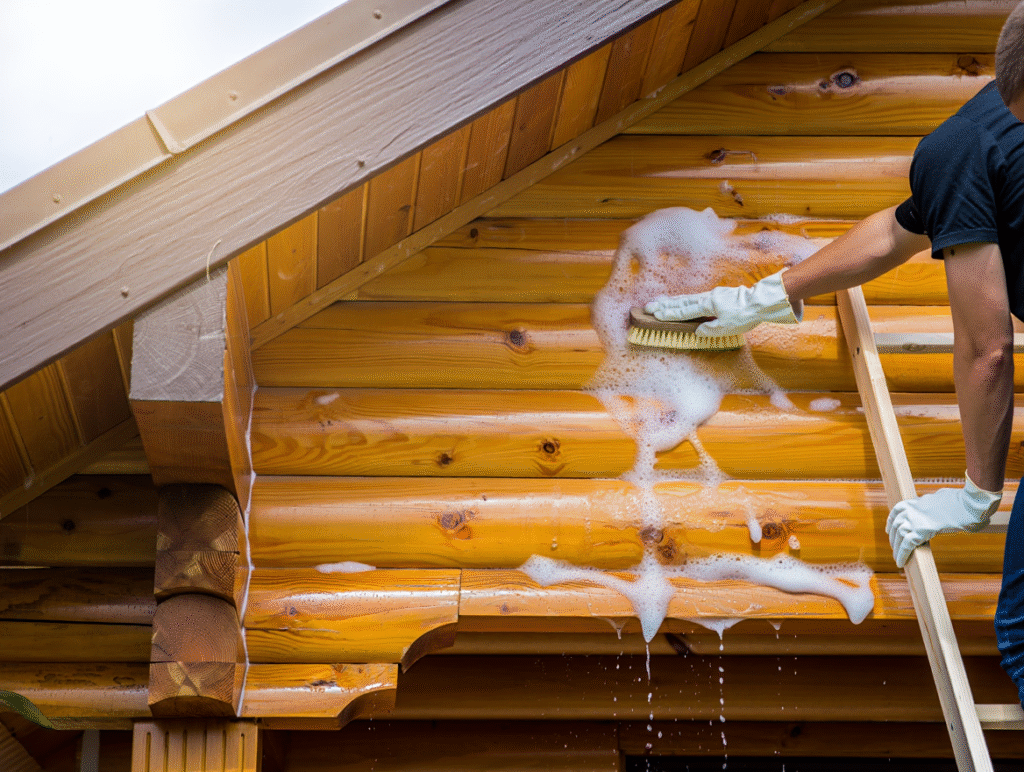
Cleaning Pine Surfaces
Keeping your pine cabin clean is the first line of defense against decay. Dirt, pollen, and grime can trap moisture against the wood. This moisture creates an environment where mold and mildew thrive. A clean surface also allows stains and sealants to adhere properly. Regular cleaning is a cornerstone of effective pine cabin maintenance. It preserves the wood’s natural beauty and prepares it for other protective treatments.
Gentle Cleaning Solutions
Aggressive cleaning methods can damage the soft surface of pine. Harsh chemicals can strip away the protective sealant and harm the wood fibers. A simple solution of mild soap and water is often sufficient for routine cleaning. For tougher spots with mildew, a mixture of one part white vinegar to three parts water works well. Always test any cleaning solution on a small, inconspicuous area first.
Here are a few recommended cleaning approaches:
- For light dirt and dust: Use a soft-bristle brush or a garden hose with a low-pressure nozzle.
- For pollen and grime: Mix a quarter-cup of gentle dish soap in a gallon of warm water.
- For mildew stains: Apply a solution of oxygen bleach, which is less harsh than chlorine bleach.
- For stubborn sap: Use a citrus-based cleaner or mineral spirits on a cloth, then rinse thoroughly.
Remember to rinse the logs completely after washing. Soap residue can attract more dirt and interfere with sealant application. Effective cabin care starts with using the right cleaning materials.
Step-by-Step Washing Guide
Washing your cabin should be done methodically to ensure a thorough job. Start from the bottom and work your way up. This technique prevents streaks from dirty water running down onto clean areas. Apply your chosen cleaning solution with a soft brush or a low-pressure sprayer. Let the solution sit for a few minutes to break down the grime, but do not let it dry on the surface.
After applying the cleaner, gently scrub any stubborn spots. Pay close attention to corners and crevices where dirt accumulates. Once you have washed a section, rinse it thoroughly from the top down. This ensures all soap and dislodged debris are washed away. Knowing how to maintain pine wood properly means mastering this fundamental cleaning process. Allow the cabin to dry completely for at least two to three days before applying any stain or sealant. This crucial drying time is a key part of pine log maintenance.
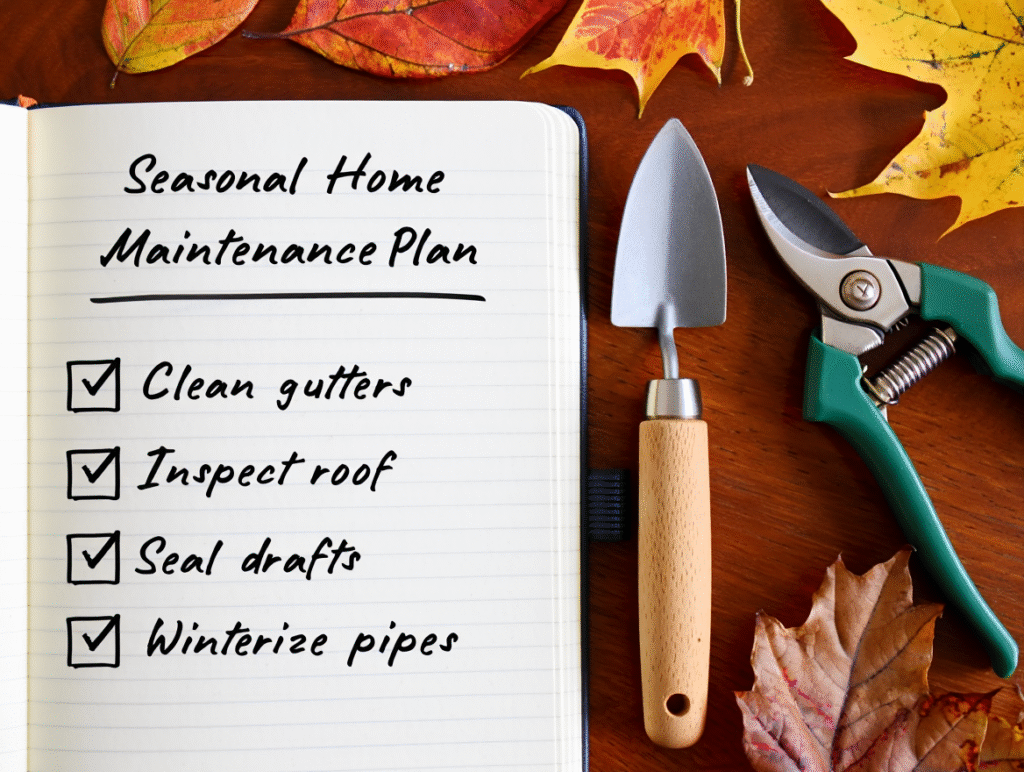
Seasonal Maintenance Checklist
A structured approach is essential for year-round cabin protection. Different seasons bring unique challenges for a wooden structure. Creating a checklist helps you stay organized and ensures no critical tasks are missed. This proactive strategy is at the heart of successful pine cabin maintenance. It transforms a large job into manageable, seasonal tasks.
A Year-Round Upkeep Schedule
Consistent care throughout the year prevents small issues from becoming big problems. Each season demands a different focus. In spring, the focus is on recovery from winter and preparation for summer. In fall, the priority is getting the cabin ready for the harsh conditions of winter. This rhythm of seasonal cabin upkeep keeps the structure in excellent shape.
Here is a sample schedule to guide your efforts:
| Season | Key Focus Areas | Specific Tasks |
| Spring | Inspection & Cleaning | Check for winter damage, wash exterior walls, inspect seals around windows and doors, clean gutters and downspouts. |
| Summer | Pest Control & Landscaping | Monitor for insect activity, trim trees and shrubs away from the cabin, check for water drainage issues. |
| Fall | Sealing & Preparation | Re-stain or reseal if needed, check the roof for damage, inspect the foundation, ensure proper ventilation in crawl spaces. |
| Winter | Monitoring & Interior Care | Check for ice dams on the roof, monitor interior humidity levels, ensure heating systems are working efficiently. |
This table provides a clear framework for your annual plan. Sticking to a schedule simplifies cabin care and makes it much more effective.
Adapting to Your Climate
Your local climate plays a huge role in your maintenance schedule. A cabin in a humid, rainy area will need more frequent checks for moisture and rot. One in a dry, sunny region may need more attention to prevent the wood from drying out and cracking. Understanding your environment is critical for proper pine cabin maintenance.
For example, cabins in the Pacific Northwest face constant dampness. This makes them highly susceptible to moss and mildew growth. Owners there might need to wash their cabins twice a year. In contrast, a cabin in the arid Southwest needs a high-quality sealant with UV protection to prevent sun damage. Tailoring your seasonal cabin upkeep plan to your specific location ensures you are addressing the most relevant threats.
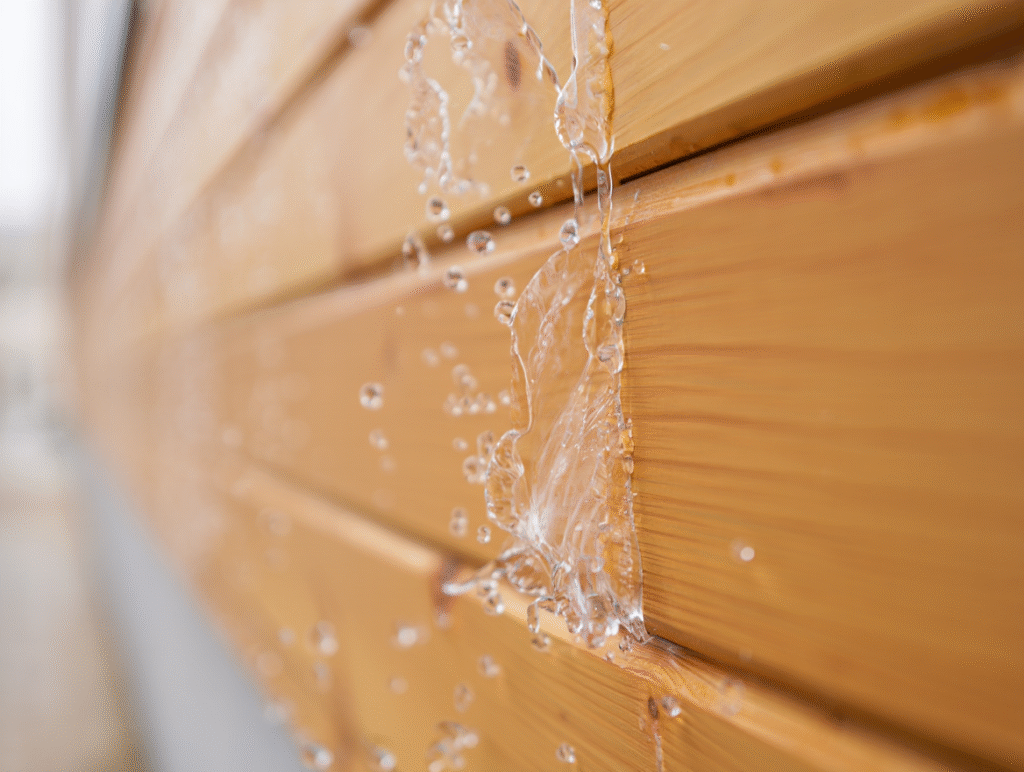
Protecting Against Moisture
Water is the primary enemy of a pine cabin. Uncontrolled moisture leads to rot, which can destroy the structural integrity of the logs. Protecting your cabin from water is perhaps the most important aspect of pine log maintenance. This involves ensuring water is shed away from the structure and that the wood itself is sealed against absorption.
The Role of Gutters and Drainage
An effective water management system is crucial. Gutters and downspouts play a vital role in directing rainwater away from the cabin walls and foundation. Clogged gutters can cause water to overflow and saturate the logs. This constant exposure can lead to serious decay over time. Clean your gutters at least twice a year, in the spring and fall.
Proper ground drainage is equally important. The ground around your cabin should slope away from the foundation. This prevents water from pooling against the base of the logs. If you notice standing water after it rains, you may need to install a French drain or regrade the landscape. Effective pine cabin maintenance includes managing the entire property, not just the structure itself.
Here are key moisture protection strategies:
- Ensure gutters are clear of leaves and debris.
- Extend downspouts to discharge water at least five feet away from the foundation.
- Maintain a consistent grade that slopes away from the cabin on all sides.
- Avoid planting shrubs or gardens too close to the walls, as they can trap moisture.
“The single most effective thing a cabin owner can do is control water. If you keep the logs dry, you’ve won half the battle against decay.” – Daniel Boone, Log Home Builder
Choosing the Right Sealant
A high-quality sealant creates a breathable barrier on the wood’s surface. This barrier repels liquid water while allowing water vapor from inside the logs to escape. This breathability is critical. An impermeable film can trap moisture inside the wood, accelerating rot from within. Look for a water-based acrylic sealant with UV inhibitors.
A study conducted in the Appalachian region found that cabins treated with a breathable, water-repellent sealant every three to five years had 80% fewer instances of log rot compared to those with less frequent or no treatment (Appalachian State University, 2021, Boone, NC). This highlights the long-term value of using the correct products. Applying sealant is a core task in how to maintain pine wood and is essential for its preservation.
Always prioritize water management. A dry cabin is a healthy cabin. Effective drainage and sealed logs are your best defense against rot.
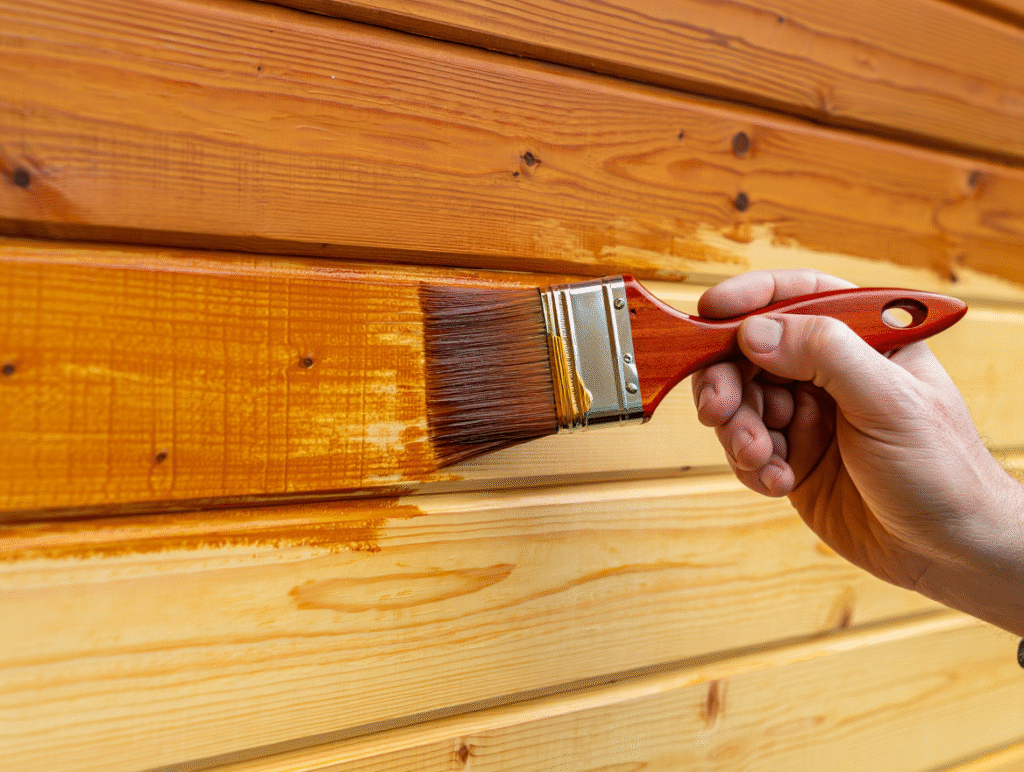
Pest Control for Pine Cabins
Insects and other pests pose a significant threat to pine cabins. Carpenter bees, termites, and powderpost beetles can bore into the logs, creating networks of tunnels that weaken the wood. Rodents can also cause damage and seek shelter within the walls. An integrated pest management plan is a non-negotiable part of pine cabin maintenance.
Identifying Common Pests
Knowing your enemy is the first step. Carpenter bees look like large bumblebees but have a shiny, black abdomen. They drill perfectly round, half-inch holes into the wood. Termites are more insidious. You may not see the insects themselves, but you might find mud tubes running up the foundation or see swarms in the spring. Powderpost beetles are tiny and leave behind small pinholes and a fine, flour-like dust.
Regular inspections help you catch infestations early. Walk around your cabin and look for signs of pest activity. Check logs, eaves, and window frames carefully. Early detection makes treatment much simpler and more effective. Swift action is a key component of effective cabin care. An unresolved pest problem can quickly escalate.
Prevention and Treatment Strategies
Prevention is always the best approach. Keep the area around your cabin clear of firewood stacks and debris, as these can attract pests. Ensure all cracks and holes in the chinking and sealing are filled to deny insects an easy entry point. A borate treatment applied to the bare wood before staining is an excellent preventative measure. Borates are toxic to insects but safe for humans and pets once sealed.
If you discover an active infestation, you may need to take more direct action. For carpenter bees, you can spray an insecticide dust into their holes and then plug the holes with a cork or dowel. For termites, a professional exterminator is almost always necessary. They may use baiting systems or liquid termiticides to eliminate the colony. Consistent pine log maintenance includes a vigilant watch for these destructive invaders.
Re-staining and Sealing
The stain and sealant on your cabin are its primary defense against the elements. Over time, sun and rain break down this protective layer. Re-staining and sealing is a critical part of the maintenance cycle. This process restores the cabin’s appearance and renews its protection against moisture and UV damage. This task is central to how to maintain pine wood effectively.
Knowing When to Re-stain
How do you know it’s time to re-stain? A simple test can tell you. Spray a bit of water on the logs. If the water beads up and runs off, the sealant is still working. If the water soaks in and darkens the wood, it’s time to apply a new coat. Look for visual cues as well. If the color is fading or the wood looks dry and gray, your cabin needs attention.
Most quality stains and sealants last between three and five years. The lifespan depends on your climate and the cabin’s exposure to the sun. The south and west walls, which get the most direct sunlight, will likely need attention sooner than the north and east walls. Regular inspection is a vital part of pine cabin maintenance.
The Staining Process: A Step-by-Step Guide
Proper surface preparation is essential for a lasting finish. The logs must be completely clean and dry before you begin. Any dirt or mildew left on the surface will be trapped under the new stain, and the new coat will not adhere properly.
Step 1: Surface Preparation Begin by thoroughly cleaning the cabin as described earlier. If the previous finish is peeling or flaking, it must be removed. This can be done by sanding, media blasting, or using a chemical stripper. This step is labor-intensive but absolutely critical for a professional-looking result. A smooth, clean surface is the foundation of a good staining job.
Step 2: Choosing the Right Stain Select a high-quality, oil-based or water-based stain specifically designed for log homes. Consider a product with pigments that offer UV protection. Lighter stains offer less protection than darker ones. Always buy a small sample and test it on an inconspicuous area to ensure you like the color.
Step 3: Application Apply the stain using a brush or an airless sprayer. A brush is often better for working the stain into the wood grain and ensuring even coverage. Work in small sections, from top to bottom. Maintain a “wet edge” to avoid lap marks. Follow the manufacturer’s recommendations for the number of coats.
Step 4: Back-Brushing If you use a sprayer, it’s important to “back-brush” the stain. This means having a second person follow behind the sprayer with a brush. This action works the stain into the wood’s pores and joints for a more uniform and protective coat. This technique is a hallmark of professional pine log maintenance.
Step 5: Apply a Clear Topcoat After the stain has cured, consider applying a clear topcoat. This adds another layer of protection against moisture and UV rays. It can significantly extend the life of the stain. This final step in your seasonal cabin upkeep can save you work in the long run.
Never apply new stain over a dirty or failing finish. Proper surface preparation is 90% of a successful staining project.
Roof and Foundation Checks
While the logs are the most visible part of your cabin, the roof and foundation are its most critical structural components. Problems in these areas can lead to catastrophic damage. Regular inspections of the roof and foundation are a non-negotiable element of comprehensive pine cabin maintenance. They protect the entire structure from the top down and the bottom up.
Inspecting Your Roof
A healthy roof is your cabin’s first defense against rain and snow. At least twice a year, inspect your roof for damage. From the ground, use binoculars to look for missing, cracked, or curling shingles. Check the flashing around the chimney and any vents. This is where leaks often start. Also, look for any moss or algae growth, which can trap moisture and shorten the life of your roofing material.
“A small roof leak can go unnoticed for months, quietly causing thousands of dollars in water damage to your logs and interior. Regular inspections are cheap insurance.” – Michael Holigan, Home Improvement Expert
After a major storm, it’s wise to do an extra inspection. If you have a metal roof, check for loose screws or panels. Any breach in the roof’s integrity needs to be addressed immediately. This proactive approach is a key part of responsible cabin care.
Maintaining the Foundation
The foundation supports the entire weight of your cabin. Inspect it seasonally for cracks, settling, or signs of water intrusion. Small hairline cracks are often normal, but any crack wider than a quarter-inch should be evaluated by a professional. Ensure that the soil around the foundation has not eroded, exposing the footings.
Proper ventilation in the crawl space or basement is also critical. Good airflow helps prevent moisture buildup, which can lead to mold growth and attract pests. Make sure vents are clear of obstructions. Good pine log maintenance means caring for the unseen parts of the home just as much as the visible ones.
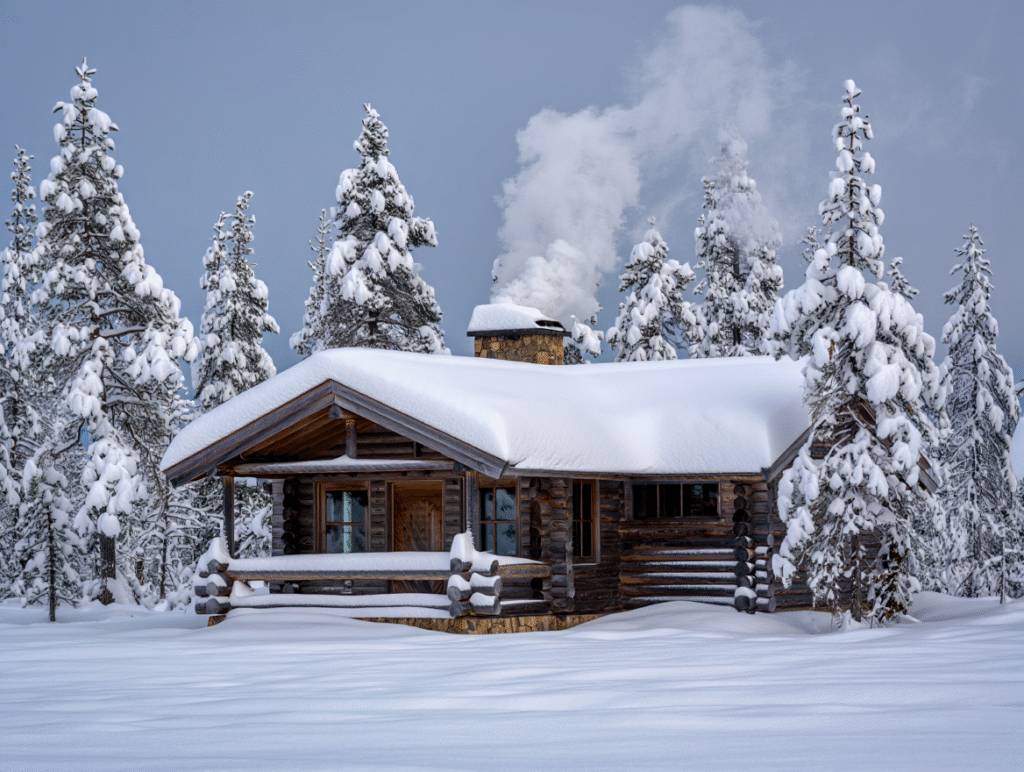
Winter Preparation
Preparing your cabin for winter is essential to prevent damage from snow, ice, and freezing temperatures. A thorough winterization process protects your plumbing, structure, and energy efficiency. This focused seasonal cabin upkeep can save you from burst pipes and other costly cold-weather disasters. Taking these steps is a vital part of pine cabin maintenance.
Protecting Pipes and Plumbing
If you won’t be using your cabin during the winter, you must drain the plumbing system completely. Water left in pipes can freeze, expand, and cause them to burst. Start by shutting off the main water valve. Then, open all faucets, and flush all toilets. Use an air compressor to blow any remaining water out of the lines. Pour a non-toxic RV antifreeze into all drains and toilet bowls.
Even if you plan to use the cabin, there are steps to take. Insulate any pipes in unheated areas like crawl spaces or attics. Seal any air leaks that could allow cold air to reach the plumbing. On very cold nights, it’s a good idea to let faucets drip slightly to keep the water moving.
Insulating and Sealing Air Leaks
Heat loss is a major concern in any home during the winter, and log cabins are no exception. Air leaks can make your cabin uncomfortable and drive up your heating bills. Check the sealing, or “chinking,” between the logs. Over time, it can crack or pull away. Re-seal any gaps with a quality caulk designed for log homes.
Weatherstripping around doors and windows can also make a big difference. Check for drafts and apply new weatherstripping where needed. A well-sealed cabin is not only warmer but also better protected from moisture and pests. This aspect of how to maintain pine wood is crucial for both comfort and preservation.
An ounce of winter prevention is worth a pound of springtime repair. A few hours of preparation in the fall can prevent catastrophic damage.
Summer Upkeep
Summer brings its own set of maintenance challenges. Increased humidity, intense sun, and higher levels of insect activity all require attention. Summer is also a great time to tackle larger projects that require warm, dry weather. Consistent summer upkeep ensures your cabin stays in top shape during the months of heaviest use. This is a pleasant but important part of pine cabin maintenance.
Managing Humidity and Ventilation
High summer humidity can promote the growth of mold and mildew, both inside and outside the cabin. Ensure your cabin has adequate ventilation. If you have an air conditioning system, run it regularly to help dehumidify the air. In bathrooms and kitchens, use exhaust fans to vent moist air outside.
A Canadian study on log home environments demonstrated that maintaining an interior relative humidity between 30% and 50% significantly reduces the risk of both mold growth and wood shrinkage/cracking (Forintek Canada Corp., 2018, Vancouver, BC). This balance is key. Proper ventilation is an often-overlooked aspect of effective cabin care.
Landscaping and Fire Safety
Summer is the time to manage the landscape around your cabin. Trim tree branches that hang over the roof. This prevents leaves from clogging gutters and reduces the risk of damage during storms. It also allows sunlight and air to reach the logs, helping them stay dry. Keep shrubs and bushes at least two feet away from the cabin walls.
Fire safety is also a major summer concern, especially in dry areas. Create a defensible space around your cabin by clearing away dead trees, brush, and other flammable materials. Keep your lawn mowed and watered. This part of seasonal cabin upkeep not only protects your property but can also be required by local ordinances.
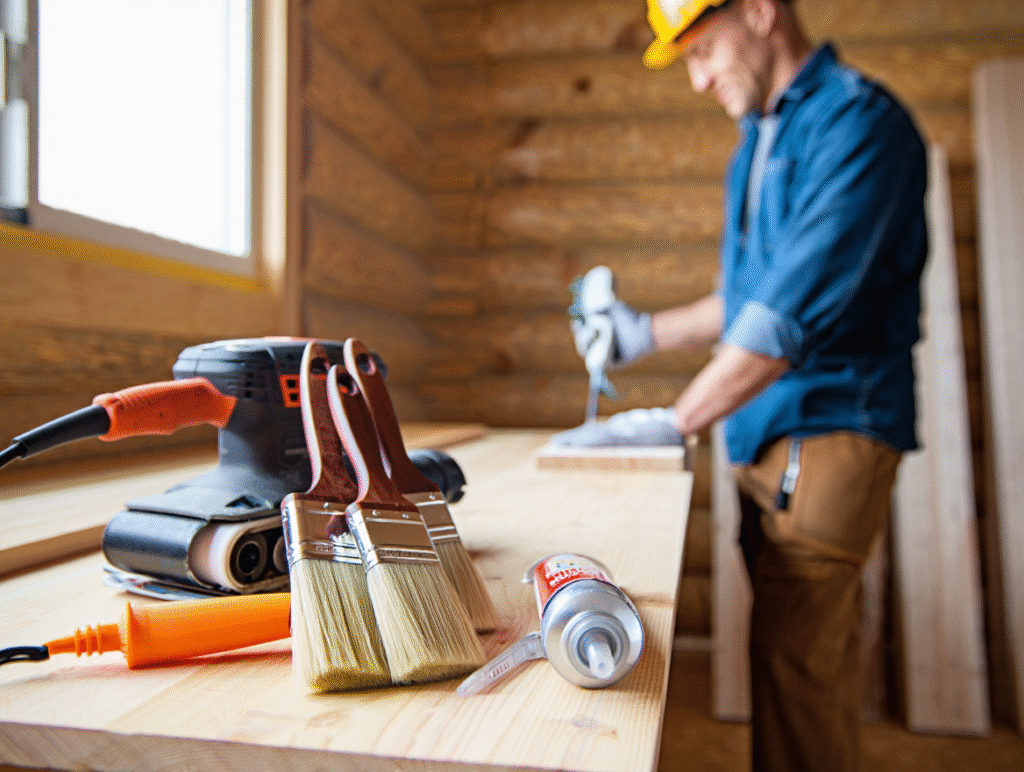
Professional vs. DIY Maintenance
Many aspects of pine cabin maintenance can be handled by a dedicated owner. However, some jobs are best left to professionals. Knowing when to call for help is important for ensuring the work is done correctly and safely. It’s a key decision in your long-term pine log maintenance strategy.
Tools You’ll Need
For those who enjoy DIY projects, having the right tools is essential. A basic toolkit can help you handle most routine tasks. It’s a good investment for anyone serious about the upkeep of their property.
Here’s a list of essential tools for the DIY cabin owner:
- Safety Gear: Goggles, gloves, and a dust mask are non-negotiable.
- Ladders: A sturdy extension ladder is needed to reach the upper logs and roof.
- Pressure Washer: Use one with an adjustable nozzle, and always use it on the lowest effective setting.
- Brushes: An assortment of soft- and stiff-bristled brushes for cleaning and staining.
- Caulking Gun: For applying new chinking and sealant around windows and doors.
- Sanders: A random orbit sander is useful for preparing surfaces for staining.
- Basic Hand Tools: A good hammer, screwdrivers, and a utility knife are always handy.
Having these tools on hand will make your pine cabin maintenance tasks much more manageable and effective.
When to Hire a Pro
While DIY maintenance can save money, some jobs require specialized skills and equipment. Jobs like media blasting to remove an old finish, treating a severe termite infestation, or significant structural repairs should be handled by experienced professionals. Roof repairs can also be dangerous and are often best left to a qualified roofer.
Hiring a professional for a major re-staining project every five to seven years can also be a wise investment. They have the equipment to do the job efficiently and can often spot potential problems you might miss. The key is to find a contractor who specializes in log homes. Their expertise is invaluable for preserving your investment.
FAQ
How often should I wash my pine cabin?
Generally, it’s a good idea to wash your cabin once a year, typically in the spring. This removes the dirt, pollen, and grime that have accumulated. However, if you live in a particularly dusty or humid area with a lot of trees, you might need to wash it twice a year to prevent mildew growth.
Why is breathability so important in a cabin sealant?
Breathability is crucial because wood naturally contains and absorbs moisture. A breathable sealant allows water vapor from inside the logs to escape. If a non-breathable sealant is used, it can trap this moisture inside the wood. This trapped moisture creates the perfect environment for rot and decay to start from the inside out.
What is better for a pine cabin, oil-based or water-based stain?
Both types have their pros and cons. Oil-based stains penetrate deep into the wood, providing excellent nourishment and conditioning. They often give a richer color. However, they can be more difficult to clean up and may be more prone to mildew. Water-based stains form a protective film on the surface, offer great color retention and UV protection, and are easier to clean up. Modern water-based formulas are extremely durable and are often preferred by professionals today.
How can I tell if my cabin has a pest problem?
Look for clear signs. For insects, this includes small holes in the wood, fine sawdust (called frass) on or below the logs, discarded wings near windows, or mud tubes on the foundation. For rodents, you might find droppings, gnaw marks, or nests made of shredded material. Regular, careful inspections are the best way to catch an infestation early.
To deepen your grasp of year-round pine cabin maintenance, watch a detailed video guide featuring practical solutions for protecting wood from moisture, decay, and pests. The author demonstrates optimal treatment sequences, explains essential products, and shares useful seasonal advice to prolong the cabin’s integrity and visual appeal. This resource covers the main maintenance techniques discussed in the article and provides you with step-by-step visuals for successful upkeep.
Conclusion
Maintaining a pine cabin is a continuous commitment, not a one-time task. It requires a year-round, proactive approach. From seasonal cleaning and pest control to staining and sealing, each step is crucial for preserving the beauty and integrity of the wood. By understanding the unique needs of pine and following a consistent maintenance schedule, you protect your cabin from the damaging effects of moisture, sun, and pests.
The effort invested in proper pine cabin maintenance pays dividends in the long run. It prevents costly repairs, maintains your property value, and ensures your rustic retreat remains a source of joy for generations. Embrace the process as part of the unique experience of log cabin ownership. A well-cared-for cabin is more than just a building; it’s a legacy. Take action today to create a maintenance plan that will protect your haven for years to come.
To help you put all this information into action, we’ve compiled a simple checklist. It breaks down the essential tasks by season and includes a quick monthly inspection routine. This practical tool makes it easy to stay on top of your pine cabin maintenance, ensuring no critical step is overlooked. Print it out, hang it in your cabin, and enjoy the peace of mind that comes with a well-cared-for home.


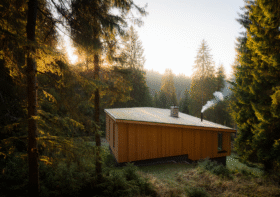
Leave a Reply